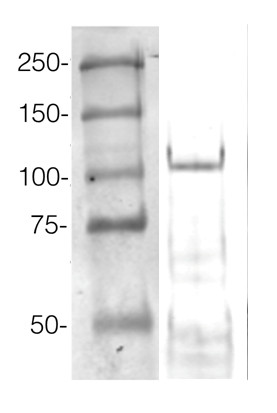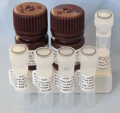1

Anti-AGO4 | Argonaute 4
AS09 617 | Clonality: Polyclonal | Host: Rabbit | Reactivity: Arabidopsis thaliana, Hyacinthus orientalis
- Product Info
-
Immunogen: KLH-conjugated synthetic peptide chosen from Arabidopsis thaliana AGO4 sequence UniProt: Q9ZVD5 , TAIR: At2g27040
Host: Rabbit Clonality: Polyclonal Purity: Immunogen affinity purified serum in PBS pH 7.4. Format: Lyophilized Quantity: 50 µg Reconstitution: For reconstitution add 50 µl of sterile water Storage: Store lyophilized/reconstituted at -20°C; Please remember to spin the tubes briefly prior to opening them to avoid any losses that might occur adhering to the cap or sides of the tube. Tested applications: CoImmunoprecipitation (IP) (coIP), Immunocytochemistry (ICC), Immunoprecipitation (IP), Western blot (WB) Recommended dilution: 1 : 100 (ICC), 5 µg of antibody per 1 gram of a fresh tissue (IP),1 : 2000-1 : 5000 (WB) Expected | apparent MW: 103 kDa
- Reactivity
-
Confirmed reactivity: Arabidopsis thaliana, Hyacinthus orientalis Predicted reactivity: Arabidopsis thaliana
Not reactive in: Brassica oleracea, Fragaria x ananassa, Hordeum vulgare, Solanum lycopersicum, Vigna angularis, Zea mays
- Application Examples
-
Application example

360 µg/well of Arabidopsis thaliana protein extracted by TCA-acetone precipitation from floral tissue and saturated in 8M urea were separated on 15% SDS-PAGE and blotted for 1hour to 0.2 µm nitrocellulose at 100V using wet transfer system. Blots were blocked with 0.5% cold fish gelatin for 1hr at room temp with agitation. Blot was incubated in the primary antibody at a dilution of 1:2500 for an hour at RT with agitation. The blots were washed with 3X 15min TBS-TT at RT with agitation. Blots as incubated in the secondary antibody (goat anti-rabbit DyLight® 800 conjugated, AS12 2460, Agrisera) 1:5000 dilution for 30 min. at RT with agitation and washed 1X with TBSTT for 15 min, 1X with TBST for 15min before scanning with the ODyssey IRD scanner.
Courtesy of Dr. Betty Chung and Pawel Baster, University of Cambridge, United Kingdom - Additional Information
-
Additional information (application): AGO expression may be tissue specific and using floral tissue is recommended where most of the AGOs are expressed the highest. Use of proteasome inhibitors as MG132 can help to stabilize AGO proteins during extraction procedure. Use a 6% gel for protein separation, which is run longer to avoid a cross-reactivity at ca. 40 kDa.
Binds endogenous siRNAs, preference for 24nt siRNAs with 5' A.
Note that the AGO4 antibody reacts with the NEB prestained protein marker. - Background
-
Background: AGO4 (Argonaute 4) belongs to a group of argonaute proteins which are catalytic component of the RNA-incudes silencing complex (RISC). This protein complex is responsible for the gene silencing (RNAi).
- Product Citations
-
Selected references: Miloro et al. (2024). Barley AGO4 proteins show overlapping functionality with distinct small RNA-binding properties in heterologous complementation. Plant Cell Rep. 2024 Mar 13;43(4):96. doi: 10.1007/s00299-024-03177-z.
Devers et al (2023) In planta dynamics, transport biases, and endogenous functions of mobile siRNAs in Arabidopsis
Yang et al. (2023) Plant-specific histone deacetylases associate with ARGONAUTE4 to promote heterochromatin stabilization and plant heat tolerance [published online ahead of print, 2023 Jan 11]. New Phytol. 2023;10.1111/nph.18729. doi:10.1111/nph.18729
Hacquard et al. (2022) The Arabidopsis F-box protein FBW2 targets AGO1 for degradation to prevent spurious loading of illegitimate small RNA. Cell Rep. 2022 Apr 12;39(2):110671. doi: 10.1016/j.celrep.2022.110671. PMID: 35417704; PMCID: PMC9035678.
Clavel et al. (2021) Atypical molecular features of RNA silencing against the phloem-restricted polerovirus TuYV. Nucleic Acids Res. 2021 Nov 8;49(19):11274-11293. doi: 10.1093/nar/gkab802. PMID: 34614168; PMCID: PMC8565345.
Oliver & Martinez. (2021) Accumulation dynamics of ARGONAUTE proteins during meiosis in Arabidopsis. Plant Reprod. 2021 Nov 23. doi: 10.1007/s00497-021-00434-z. Epub ahead of print. PMID: 34812935.
Niedojadlo et al. (2020). Dynamic distribution of ARGONAUTE1 (AGO1) and ARGONAUTE4 (AGO4) in Hyacinthus orientalis L. pollen grains and pollen tubes growing in vitro. Protoplasma. 2020 Jan 8. doi: 10.1007/s00709-019-01463-2.
Sprunck et al. (2019). Elucidating small RNA pathways in Arabidopsis thaliana egg cells. http://dx.doi.org/10.1101/525956
Yang et al. (2017). The developmental regulator PKL is required to maintain correct DNA methylation patterns at RNA-directed DNA methylation loci. Genome Biol. 2017 May 31;18(1):103. doi: 10.1186/s13059-017-1226-y.
Li et al. (2016). Biogenesis of phased siRNAs on membrane-bound polysomes in Arabidopsis. Elife. 2016 Dec 12;5. pii: e22750. doi: 10.7554/eLife.22750.
Zhai et al. (2015). A One Precursor One siRNA Model for Pol IV-Dependent siRNA Biogenesis. Cell. 2015 Oct 8;163(2):445-55. doi: 10.1016/j.cell.2015.09.032.
Han et al. (2014). SUVR2 is involved in transcriptional gene silencing by associating with SNF2-related chromatin-remodeling proteins in Arabidopsis. Cell Res. 2014 Nov 25. doi: 10.1038/cr.2014.156. (coimmunoprecipitation).
Zhang et al. (2013). DTF1 is a core component of RNA-directed DNA methylation and may assist in the recruitment of Pol IV. PNAS, May 14.
Havecker et al. (2010) The RNA-directed DNA methylation Arabidopsis Argonautes functionally diverge based on expression and interaction with target loci. Plant Cell 22(2): 321-34. - Protocols
-
Agrisera Western Blot protocol and video tutorials
Protocols to work with plant and algal protein extracts
Agrisera Educational Posters Collection
TCA/Acetone protein precipitation method for plant proteins- Grind plant tissue in a liquid nitrogen.
- Continue grinding with 10% TCA solution in acetone (ice cold).
- Precipitate overnight in -20C.
- Spin at 4°C for 1min, 17k rpm > wash with ice cold acetone until you obtain a white pellet.
- Dissolve the pellet in buffer of choice (for example 8M urea containing 5mM DTT, or denaturate in SDS protein loading buffer for 10 min. at 70°C)
- Clarify supernatant
- Measure protein concentration.
- Proceed with a western blot.
Example of a western blot result obtained with this method, which allows high protein load per well, can be found below.

360 µg/well of Arabidopsis thaliana protein extracted by TCA-acetone precipitation from floral tissue and saturated in 8M urea were separated on 15% SDS-PAGE and blotted for 1hour to 0.2 µm nitrocellulose at 100V using wet transfer system. Blots were blocked with 0.5% cold fish gelatin for 1hr at room temp with agitation. Blot was incubated in the primary antibody at a dilution of 1:2500 for an hour at RT with agitation. The blots were washed with 3X 15min TBS-TT at RT with agitation. Blots as incubated in the secondary antibody (DayLight 800) 1:5000 dilution for 30 min. at RT with agitation and washed 1X with TBSTT for 15 min, 1X with TBST for 15min before scanning with the ODyssey IRD scanner.
Courtesy of Dr. Betty Chung and Pawel Baster, University of Cambridge, United Kingdom
BACK to Plant Protocols page - Reviews:
-
Jacinthe AZEVEDO FAVORY | 2021-10-26anti-AGO4 worked for IP at 1/500 (A.thaliana and A.halleri buds )Feng Wang | 2014-09-09The antibody works well for western blot with an dilution of 1:5000. Cross-activity has been detected at around 40kd.Katarzyna Niedojad?o | 2012-04-23Antibodies were used in immunocytochemistry methods in Hyacinthus orientalis and diluted 1:100.
Accessories

This set contains:
- 4 Anti-AGO antibodies of your choice, chosen from a drop down menu below
- Matching secondary antibody, HRP conjugated, min. 1: 25 000, 1h/RT (AS09 602 - trial)


